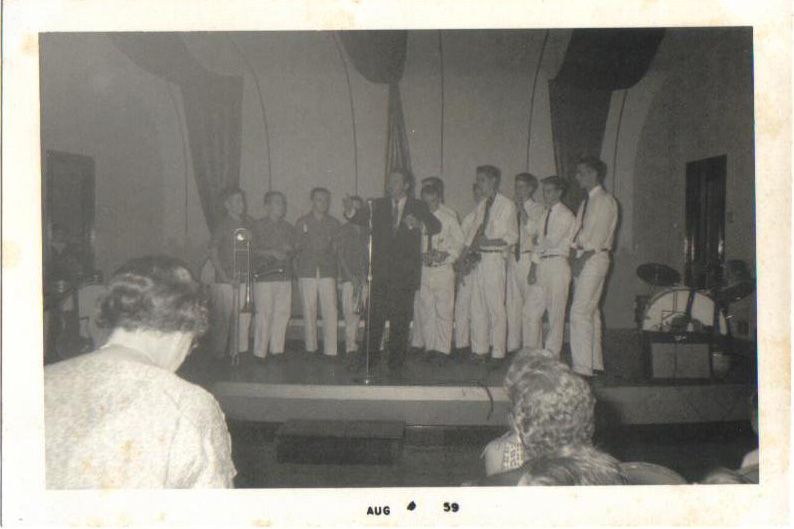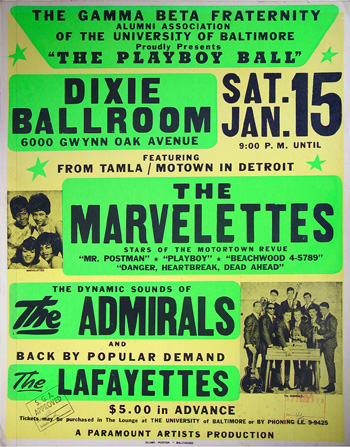The Dixie BallroomThe Dixie Ballroom was a dance hall located within Gwynn Oak Park, a privately owned amusement park about ¼ mile off of Liberty Heights Avenue at the corner of Gwynn Oak and Gwyndale Avenues in Woodlawn. This photo is the only one I've been able to track down showing the inside of the Dixie Ballroom. From August, 1959, it shows the Poker Chips and the Admirals on stage together, with an unidentified MC. This was a talent competition in which both bands competed. it's amazing the difference a couple years can make at that age; the 12-13 year old Poker Chips look very young next to the slightly older Admirals. Gwynn Oak was the longest operating park in the Baltimore area, opening in 1893 and surviving (if not always thriving) until a perfect storm of bad publicity, bad finances and Hurricane Agnes led to its eventual closing in 1973. In 1909, The Sun paper hailed Gwynn Oak as “the great picnic and Sunday school excursion ground of the city,” and indeed many Baltimoreans remember school trips to Gwynn Oak to celebrate First Holy Communions or spring graduations. The park offered many rides and amusements, tennis courts, a baseball diamond, ice skating in the winter and pleasure boating, but to a certain generation Gwynn Oak will always be associated with the Dixie Ballroom. Folks dressed in coats and ties danced to the music of Artie Shaw, Glenn Miller, or local bandleader Bob Craig. On the weekends local AM radio station, WFBR, did live broadcasts from the ballroom. When rock’n'roll replaced big band music in popularity the Dixie Ballroom eventually closed. This writer knows it was open into the late 1950s because I played there in a "talent contest" that included prominent local entertainers of the time like the Picarelli Brothers and Beverly Ann Smith. We, the Poker Chips, made it to the finals playing dixieland music where we were finally knocked out by one of those new-fangled rock and roll bands, The Galaxies. Despite its longevity, changing times had serious consequences for Gwynn Oak. In 1963, the segregated park resisted integration and received national press (including an article in Time Magazine) after nearly 400 whites and blacks, among them Protestant, Catholic and Jewish religious leaders, marched on Gwynn Oak on July 4 to protest the “whites only” policy—a scene rendered (with much poetic license) in John Waters’ film “Hairspray.” Nearly 300 protesters were arrested and taken by school buses to the Woodlawn Police Station. Gwynn Oak closed in 1973, ending the history of the longest operating amusement park in Baltimore. Photos of the Dixie Ballroom have been hard to come by, but we did find this nostalgic video portrait of Gwynn Oak.
SOURCES: Following are the recollections of Brian Pinson ... While it's true that after the big band sound era the venue wasn't particularly popular, it did have a renaissance in the mid 60's and early 70's until its demise in 1973. In the mid 60's, there were dances every Friday night and the most popular band that appeared there was the Uptowns. I also remember high school fraternities having dances and bringing in James Brown, the Drifters, the Coasters. and Sam & Dave. The Van Dykes also played there. The dances were held in the winter and when Milford Mill Swim Club opened up in the spring, the dances shifted to that venue. The Van Dykes were extremely popular, as well as Tommy Vann & the Echoes, Frankie and the Spindells, and the Uptowns. Sometime in the late 60's, the ownership of the swim club went in a different direction and stopped the dances; however, the dances continued at Dixie Ballroom. They weren't held every night, but more on the order of every 2 weeks. At this point the popular groups that had held sway for the older generation of Doo Woppers were now replaced by a different type of band. Where soul music was once supreme, now Top 40 groups such as Appaloosa were the vogue. Then the terrible storm hit and leveled Dixie Ballroom. The Gwynn Falls River or Stream had destroyed all that I loved and remembered. After Hurricane Agnes, the park was destroyed and the area was declared a flood plain and couldn't be rebuilt. I lived on Flannery Lane well within walking distance of the park. Gone were the train tracks, the motor boats, etc. Now the area is a beautiful landscaped park; however, all the houses that bordered the park on Gwynndale Ave are gone.
|
|---|
About Us | Contact Us |



